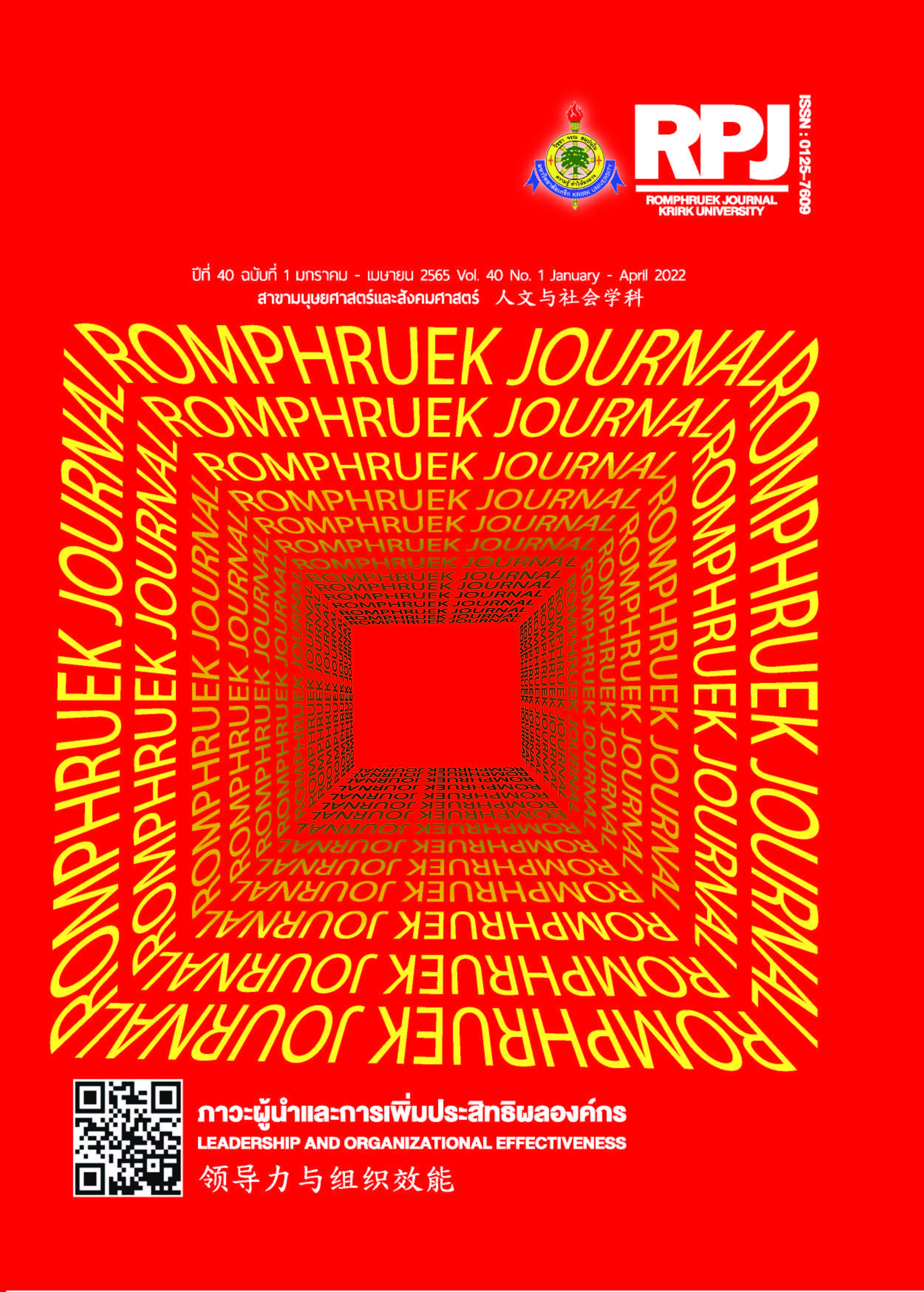Fake News : An Important Problem That Needs To Be Urgently Solved
Main Article Content
Abstract
“Fake news” is a persistent problem which already becomes a normal issue in society. The content of fake news can convince and guide people, no matter who they are, from individuals to global society to make a change in beliefs, way of life, social activity, and international relations, etc. As a result, fake news can creates panic, hatred, conflict, and even damage to life and property. No matter what is a reason of distribution intentionally or not.
In the past, the spread of fake news was mainly for political, government, and military purposes, in what is known as “Propaganda” with the clear intent of building beliefs, fears, loyalty to form a unity of support for their groups.
Nowadays, social media has rapidly progressed. A content dispatcher can generate revenue from readers, followers, and forwarders. So many stories and issues are created and published. Sometimes these are merely just for enjoyment, fun, or trending, regardless of whether it is true or false.
“Fake news” will continually exist in society. Even it is under strict control and audits from both the public and private sectors. Therefore, we must face “fake news” with awareness and consciousness. Most important, we must not be a part of the vicious cycle of fake news.
Article Details

This work is licensed under a Creative Commons Attribution-NonCommercial-NoDerivatives 4.0 International License.
Every article published in the Romphruek Journal of the Humanities and Social Sciences is the opinion and point of view of the authors. Thery're not the viewpoint of Krirk University or the editored department. Any part or all of the articles for pablication must be clearly cited.
References
กัณฐัศศา พงษ์หิรัญ. (2562). ภาพยนตร์โซเวียตกับบทบาทการโฆษณาชวนเชื่อทางการเมืองตามหลักของ
สังคมนิยมคอมมิวนิสต์. การประชุมวิชาการบัณฑิตศึกษาระดับชาติ สรรพศาสตร์ สรรพศิลป์ ประจำปี 2562. วันที่ 27-28 มิถุนายน 2562 ณ คณะศิลปศาสตร์ มหาวิทยาลัยธรรมศาสตร์ กรุงเทพฯ. 81.
กระทรวงดิจิทัลเพื่อเศรษฐกิจและสังคม. (2564). ดีอีเอสเผยตัวเลขดำเนินคดีข่าวปลอมปี 63-64. (17 กันยายน 2564) สืบค้นจาก https://www.mdes.go.th/news/detail/4722-ดีอีเอส-เผยตัวเลขดำเนินคดีข่าวปลอมปี-63-64.
ขจรฤทธิ์ นิลกําแหง. (2559). การปฏิบัติการข่าวสารกับความมั่นคงของชาติ. วารสารรัฏฐาภิรักษ์. 58(3), 72.
ธาม เชื้อสถาปนศิริ. (2557). “USER-GENERATED CONTENT” : ยุคสื่อของผู้ใช้. (13 สิงหาคม 2557) สืบค้นจาก https://positioningmag.com/58244.
บริคอินโฟ. (2562). ทำความรู้จัก DeepFake ใช้ AI สร้างคลิปปลอมของคนดัง ที่ปลอมยันเสียงและท่าทาง. (13 กรกฎาคม 2562) สืบค้นจาก https://www.brickinfotv.com/news/technology/8147/.
ประยุทธ์ จันทร์โอชา. (2564). พี่น้องประชาชนชาวไทยที่รักทุกท่านเมื่อวานนี้. (27 กรกฎาคม 2564) สืบค้นจาก
https://www.facebook.com/prayutofficial/photos/a.464772180685069/1148543772307903?_rdc=1&_rdr.
พิชญาพร ประครองใจ. (2558). หลักนิเทศศาสตร์. กรุงเทพฯ : จุฬาลงกรณ์มหาวิทยาลัย.
พิชิต วิจิตรบุญยรักษ์. (2554). สื่อสังคมออนไลน์ : สื่อแห่งอนาคต. (1 พฤศจิกายน 2564) สืบค้นจาก
https://www.bu.ac.th/knowledgecenter/executive_journal/oct_dec_11/pdf/aw016.pdf
พุทธชาด ตรีราภี. (2562). เปรียบเทียบและวิเคราะห์บทบาทของโฆษณาชวนเชื่อก่อนและหลังนโยบายกลาสนอสต์เปเรส ทรอยกา กรณีศึกษา : โปสเตอร์ทางการเมือง. คณะศิลปศาสตร์ มหาวิทยาลัยธรรมศาสตร์, กรุงเทพฯ.
สุรชาติ บำรุงสุข. (2553). ปฏิบัติการข่าวสาร Information Operation. กรุงเทพฯ : บริษัท สแควร์ ปริ๊นซ์ 93 จำกัด.
สำนักงานราชบัณฑิตยสภา. (2563). พจนานุกรมศัพท์นิเทศศาสตร์ ฉบับราชบัณฑิตยสภา. กรุงเทพฯ : สำนักงานราชบัณฑิตยสภา.
องค์การเพื่อการศึกษา วิทยาศาสตร์ และวัฒนธรรมแห่งสหประชาชาติ. (2563). การเสนอข่าว ‘ข่าวลวง’ และข้อมูลบิดเบือนคู่มือเพื่อการศึกษาและอบรมด้านวารสารศาสตร์ ชุดเอกสารเพื่อการศึกษาด้านวารสารศาสตร์ของยูเนสโก. กรุงเทพฯ : สำนักพิมพ์บุ๊คสเคป.
อุมาดา ปิ่นทอง. (2552). การก่อกำเนิด การดำรงอยู่ การล่มสลาย ของขบวนการเคลื่อนไหวทางสังคมแนวใหม่ : ศึกษากรณีสำนักหุบผาสวรรค์. ปรัชญาดุษฎีบัณฑิต วิทยาลัยสื่อสารการเมืองมหาวิทยาลัยเกริก, กรุงเทพฯ.
Berlo, David K. (1960). The Process of Communication. New York : Holt, Rinehart and Winston, Inc.
LongDo Dict. (2563). Deepfake คืออะไร ทำไมใครๆ ก็พูดถึง. (19 มีนาคม 2563) สืบค้นจาก
https://dict.longdo.com/blog/deepfake/.
Nutn0n. (2561). รู้จักกับ Fake News ทั้ง 7 รูปแบบ ที่เราเจอกันทุกวันบน Fakebook, Twitter. (21 พฤศจิกายน 2561) สืบค้นจาก https://www.rainmaker.in.th/7-type-of-fake-news/.
Post Today. (2563). โคตรเซียน “ไอโอ” คือไอโอรัสเซีย. (2 ธันวาคม 2563) สืบค้นจาก
https://www.posttoday.com/world/639342-[/
SPRING LiFE. (2564). หรือนี่อาจเป็นสาเหตุของ Fake News! เสพโซเชียลเกินไป ภัยเงียบที่คาดไม่ถึง. (18 สิงหาคม 2564) สืบค้นจาก https://www.springnews.co.th/blogs/spring-life/814281


